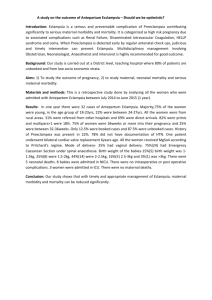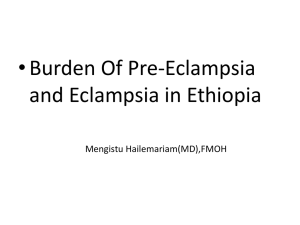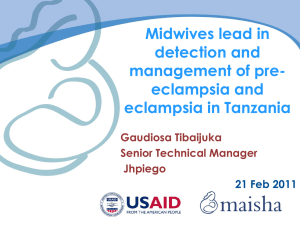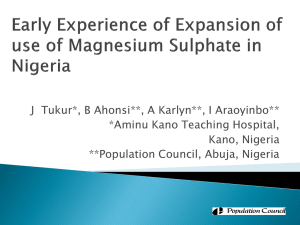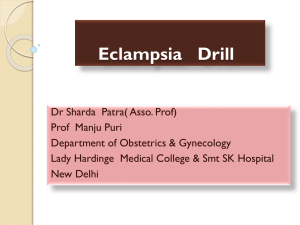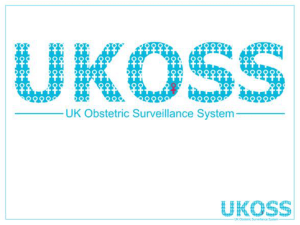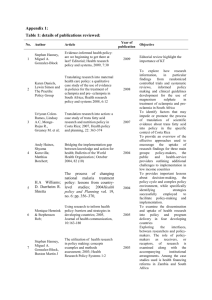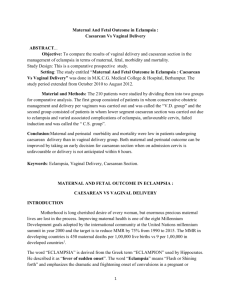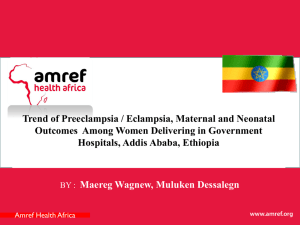Original article Title: “The Maternal Outcome in Antepartum
advertisement
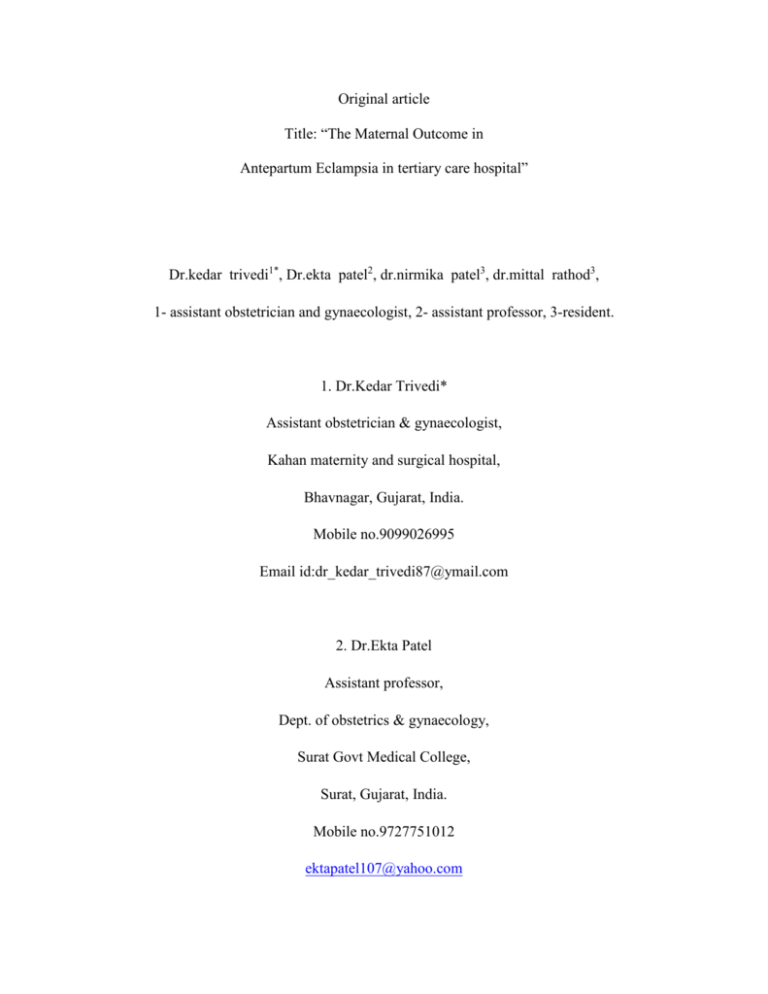
Original article Title: “The Maternal Outcome in Antepartum Eclampsia in tertiary care hospital” Dr.kedar trivedi1*, Dr.ekta patel2, dr.nirmika patel3, dr.mittal rathod3, 1- assistant obstetrician and gynaecologist, 2- assistant professor, 3-resident. 1. Dr.Kedar Trivedi* Assistant obstetrician & gynaecologist, Kahan maternity and surgical hospital, Bhavnagar, Gujarat, India. Mobile no.9099026995 Email id:dr_kedar_trivedi87@ymail.com 2. Dr.Ekta Patel Assistant professor, Dept. of obstetrics & gynaecology, Surat Govt Medical College, Surat, Gujarat, India. Mobile no.9727751012 ektapatel107@yahoo.com 3. Dr.Nirmika Patel 3rd year resident, Dept. of community medicine, M.P.Shah Govt Medical College, Jamnagar, Gujarat, India. Mobile no.9429133247 drnirmikapatel@ymail.com 3. Dr. Mittal Rathod 3rd year resident, Dept. of community medicine, M.P.Shah Govt Medical College, Jamnagar, Gujarat, India. Mobile no.903333649 dr.mittal74@gmail.com ABSTRACT Background: Everyday new theories are emerging in field of eclampsia. After years of vast experience and exhausting research it is yet one of the most challenging problem of obstetrics. It is a very common complication of pregnancy and one of the most common causes of maternal mortality and morbidity. Aim and objective: The aim of study to know maternal outcome in cases of antepartum eclampsia. The objective is to decrease maternal or perinatal morbidity and mortality by knowing their causes and by detecting the complications early and treating them effectively. Materials and methods: This is an observational (prospective) study of 70 cases of antepartum eclampsia, carried out at G. G. Hospital Jamnagar from Sep. 2011 to Aug. 2012. The patients were analysed in Relation to type of admission, Blood pressure on Admission, Proteinuria, Incidence, Age, Parity, Foetus (Live/Still birth) on admission, mode of delivery, Incidence of operative interventions, complications of antepartum eclampsia, treatment. Results: Incidence of Antepartum eclampsia during this study period is 1%. Most of the patients of antepartum eclampsia were ≤24 years. study 53% of patients had hospital stay of >7days. KEYWORDS: eclampsia, antepartum, convulsion, L.S.C.S. INTRODUCTION Eclampsia is a life threatening emergency that contributes to be a major cause of serious maternal morbidity and is still the leading cause of maternal mortality world wideA, B. It is estimated that every year eclampsia is associated with about 50, 000 maternal death worldwide, most of which occur in developing countriesB. It is one of the common cause of maternal mortality and responsible for 20 % of maternal deathC. Low educational status and low socioeconomic condition among the rural people is the main cause of absence of antenatal care and development of eclampsia. Antepartum eclampsia is more dangerous than postpartum eclampsia. Incidence of eclampsia in India is 0.94 to 1.8% in all pregnanciesD .Magnesium sulfate is most preferred anticonvulsive agent and has been very effective in reducing maternal and perinatal mortality and morbidityE. Aims and Objectives: - To know the rate of eclampsia in antenatal women attending tertiary care hospital of study area. - To analyse the epidemiological and clinic profile of patients of antepartum eclampsia. - To evaluate maternal morbidity, maternal mortality in different mode of delivery in cases of antepartum eclampsia. - To evaluate the control of blood pressure with anti-hypertensive, control of convulsions with anticonvulsants. MATERIALS AND METHODS This observational (prospective) study was carried out in 70 cases of antepartum eclampsia, carried out at a tertiary care institute of Jamnagar from Sep. 2011 to Aug. 2012.On admission a detailed history was elicited and thorough general, systemic examinations carried out and all required laboratory investigations done. The history taking and examinations were performed in details. The patients were analysed in Relation to type of admission (Emergency/Booked), Blood pressure on Admission, Proteinuria, Incidence, Age, Parity, mode of delivery, Incidence of operative interventions, causes of perinatal morbidity/mortality, complications of antepartum eclampsia, control of blood pressure with anti-hypertensive, control of convulsions with anticonvulsants. Results Out of 6965 delivery 70 patients with antepartum eclampsia, which shows incidence of Antepartum eclampsia during this study period is 1%. Table: 1 socio-demographic profile of the patient variable participant No. of patient percentage Age of patient <24 years 63 90% >24 years 7 10% Rural 40 56% Urban 30 44% Hindu 49 70% Muslim 21 30% Residence Religion Table shows 90%patients of antepartum eclampsia were ≤24 years. High incidence in rural areas compare to urban area.70% patient belongs to Hindu religion. Table: 2 obstetric history of patient in relation to week of pregnancy, gravida and mode of delivery variable categories No. of patient percentage Weeks of pregnancy <30 weeks 5 44% 30-35 weeks 26 >35 weeks 39 56% primi 48 68% Other than primi 22 32% Vaginal delivery 35 50% Vaccum/forcep 3 5% Gravida Mode of delivery assisted V.D. L.S.C.S. 32 45% 44% of cases in antepartum eclampsia were pre term (<35 weeks).68% of the patients were primi gravida (in the study)In present study 55% cases had vaginal delivery out of them 5% were instrumental deliveries. Out of 70 cases only 30 were booked cases, 40(56%) were emergency cases having no antenatal visit. This shows tremendous importance of antenatal visit. Table: 3 Clinical presentations of women with eclampsia Clinical presentation No. of patients(n=70) Headache 59(84%) Blurring of vision 7(10%) Epigastric pain 10(14%) Decreased urine output 5(7%) Oedema of feet 58(83%) The table shows that most common symptom preceding antepartum eclampsia is headache which is seen in 84% of cases. The most common sign in cases of ante-partum eclampsia is pedal oedema. Table: 4 Complications of antepartum eclampsia with different mode of delivery Complications V.D. N=35 Vaccume / forcep assisted V.D. N=3 L.S.C.S N=32 HELLP syndrome 3(12%) 1(33.3%) 0 A.R.F. 2(18%) 0 0 C.R.F. 0 0 0 Abruptio palcenta 1(35%) 0 2(6.25%) I.C.H. 0 0 0 Wound gap 0 1(33.3%) 1(3.2%) Post partum Haemorrhage 1(35%) 0 3(10%) Pulmonary oedema 0 0 0 In this study 21% cases had complications. Table: 5 cases of ante-partum eclampsia divided on bases of blood pressure on admission Total < 140/90 mmhg 140-160/90-110mmh 70(100%) 10(15%) 18(25%) 160/110 mmhg 42(60%) 85% of cases of antepartum eclampsia had blood pressure >140/90mmhg. But the remaining 15% had convulsion with B.P. < 140/90 mm of Hg. Table: 6 Cases divided as per need of anticonvulsant for control of convulsions Total No MgSO4 MgSO4→→ Phenytoin 70 63 (90%) 7 (10%) In present study 90% of cases convulsions were controlled with use of MgSO4 as a primary agent. In 10% uncontrolled cases phenytoin was used. Table: 7 Cases of antepartum eclampsia divided on basis of dip-stick protein. Urine albumin Trace +1 +2 +3 No of cases 5 30 30 5 Percentage 7% 43% 43% 7% 93% of cases had proteinuria >+1. Table: 8 Cases divided as per need of anticonvulsant for control of convulsions Total No MgSO4 MgSO4→→ Phenytoin 70 63 (90%) 7 (10%) In present study 90% of cases convulsions were controlled with use of MgSO4 as a primary agent. Cap Nifidipine (10mg) 1 BD to 1 QDS was used as the first line drug. It controlled B.P. in 84% cases as a single agent. It controlled B.P. in remaining 13% cases when Injection Labetolol was added. In 3% cases the B.P. was still uncontrolled in which N.T.G. drip was used. Discussion The study (observational, prospective) consists of analysis of 70 cases of Antepartum Eclampsia which were treated at tertiary care hospital Jamnagar from Sept 2011 to Aug 2012. Incidence of Antepartum eclampsia is 1% in this study.Incidence of eclampsia in India is 0.94 to 1.8% in all pregnanciesD.190%patients of antepartum eclampsia were ≤24 years in this study which comparable to other studies like, prospective study by Dr. Kumar MajhiF 58% cases were <22 years And Ikechebelu JK, 2002 study, Nigeria had 68% cases <23 years. Out of 70 cases only 30 were booked cases, 40(56%) were emergency cases having no antenatal visit. This shows tremendous importance of antenatal visit. High incidence in rural areas can be explained by illiteracy, ignorance, poverty, lack of antenatal care. Most pitiable thing is that 44% patients were from urban areas, suggestive that inspite of available hospital facilities they don’t consider it important to take proper antenatal care. 44% of cases in antepartum eclampsia were pre term (<35 weeks) which is comparable with other studies like Case study by Husain Lekidanto,N Tanzania had 73% cases having pregnancy <34wks. The most common symptoms seen before antepartum eclampsia is headache which is seen in 84 of cases The most common sign is in cases of ante-partum eclampsia is pedal oedema which is comparable with other studies like in McCabbin J NH 2002, study 61% cases had pedal oedema and in Lee wJ, 2004 study 80% cases had headache as a preceding symptoms before eclampsia. Onuh S OO 2004, Benin study 82.4% cases had headache, 10.6% cases had visual disturbances, and 7% had epigastric pain. John FranceP 2011, study 88% cases had headache 66% had frontal headache, visual problems were present in 34% cases. Primi gravida definitely is at a higher risk to develop antepartum eclampsia. 68% of the patients were primi gravida (in the study) In present study 55% cases had vaginal delivery out of them 5% were instrumental deliveries. Incidence of L.S.C.S in present study was 45%.Incidence of L.S.C.S. (%) in other studies, Datta M. R.I 2002 L.S.C.S. 62 %( diazepam used,) 55 %( MgSO4 used), Lee W L 2004, Nova Scotia L.S.C.S. rate 79%.In this study 21% cases had complications. While in Lee WL Complication seen in 32% cases and in M C Cabbin J HG Incidence of abruptio placenta in cases with ante-partum eclampsia was 13% and in Tuffnel DM Incidence of Pulmonary oedema 2.3% in ante-partum eclampsia, incidence of A.R.F/C.R.F. (0.5%). 85% of cases of antepartum eclampsia had blood pressure >140/90mmhg. But the remaining 15% had convulsion with B.P. < 140/90 mmhg. This explains that cases of convulsions in pregnancy should be considered ante-partum eclampsia till the other cause found. Blood pressure may be < 140/90mmhg in this cases.in this study 93% of cases had proteinurea >+1 ,which is comparable with study Mc Cabbin J NH 2002 in which 79% cases had proteinuria >+1.In present study 90% of cases convulsions were controlled with use of MgSO4 as a primary agent. In 10% uncontrolled cases phenytoin was used.in other studies, Pritchard J AQ use of MgSO4 100%, in Hangora V SR91.2% and in Datta M RI was 98%. Conclusion Antepartum eclampsia is one of the most challenging and unsolved problems for Indian obstetrics. It is one of the chief causes of maternal morbidity as well as mortality. The study shows that only availability of health services is not enough. People are unaware about the consequences which may occur due to lack of antenatal care. Enthusiastic attempts to provide antenatal care and attempts to explain its importance is mainstay of the treatment. Good control of blood pressure and convulsions improves both maternal outcomes. MgSO4 as an anticonvulsant controls convulsions in 90% of cases. Early detection of complications and treatment of them decreases maternal morbidity and can even prevent maternal mortality. References A) Gaddi SS, Somegowda(2007) . Maternal and perinatal outcome in eclampsia in a district hospital. The Journal of Obstetrics & Gynecology of India. 2007; 57: 324-326. B) Tukur J(2009) .The use of magnesium sulphate for the treatment of severe pre-eclampsia and eclampsia. Annals of African Medicine. 2009; 8:76-80. C) BMMS 2010. D) Chelsy LC(1978).Hypertensive disorders in pregnanacy.Newyork: Appleteon centuary croft 1978; p2 E) Saha S. Saha A(2002).Clinical audit of perinatal mortality: A reappraisal of major determinants and its prevention.J Obster Gynecol Ind 2002;52:83-86 F) Kumar Majhi, Sorathy Chakravorty, (2000) Calcutta; (Eclampsia present scenario in medical college, Calcutta) Obstet. Gynecol India, 2000; 50:128-32. G) Ramadan B K, Sibai B M, Chari R S, (2001); Pregnancies complicated of HELLP syndrome prognosis. American Journal Obstet Gynecol; 2001:172(i):125 H) M C Cabbin J N, Anderson G P, Sibai B M – (2002) Observations in Eclampsia Obstet Gynecol, 2002; 58(5):609 I) Datta M R, Pantl, Kabiraj M, (2002); MgSO4 in eclampsia, a safe and effective approach Journal of Obstet Gynecol India 2002; 52(3):65 J) Kaur P, Saini A S, Kaur A, Dhillon S P S,(2003); Hellp syndrome associated with severe PIH and eclampsia.;Journal of Obstet Gynecol India, 2003;53:115 k) Owley L, Henderson Smart D, (2003); MgSO4 V/S diazepam for eclampsia Cochrane database, system Rev 2003. L) Lee W, O’cnnel C M, Baskett T F, (2004);Maternal and perinatal outcome of eclampsia Nova scotia (1988-2000) M) Tuffnel D J, Jankowiz, D, Lindow S. W. (2005); Outcome of causes of severe P.I.H./eclampsia Yorkshire BJOG, 2005:112(7):875 N) Husain Lekidanto, Inqrid Mogern, Gunilla Lind morn,(2009) Management of Eclampsia, Patients a tertiary hospital, Dar-e-salam, Tanzania. O) ONUH SO, Aisen A O, (2004); Maternal and foetal outcome in eclampsia, Benin, Nigeria;Journal of Obstet Gynecol, 2004 Oct. 24(7):765-8 P) John France, (2011); Characteristics of symptoms of imminent eclampsia, a cause study from a tertiary hospital Tanzania. OJOG, 2011; (Sep) Vol.2 Chep-3 Q) Pritchard J A, Cannighan F G, Pritchard S A(1984), MgSO4 in eclampsia; American Journal Obstet Gynecol 1984:148(7):45 R) Gokhrook, Sharma G, Sharma M, (2001) ;Various maternal factors responsible for meconium stained Amniotic fluid Journal Obstet gynecol, India 2001;51(5):76
